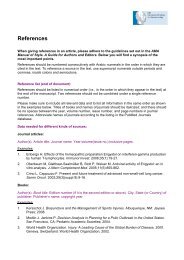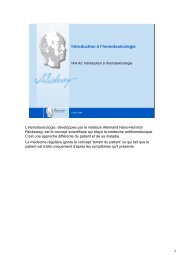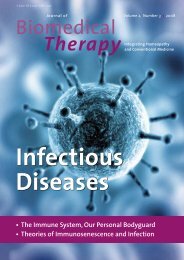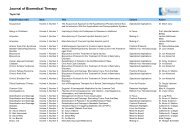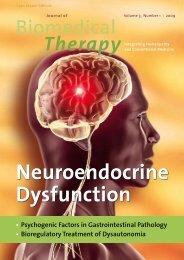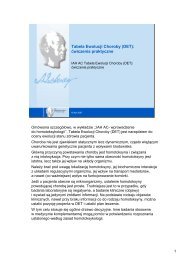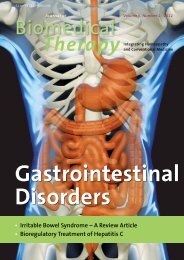Biomedical Therapy - International Academy of Homotoxicology
Biomedical Therapy - International Academy of Homotoxicology
Biomedical Therapy - International Academy of Homotoxicology
Create successful ePaper yourself
Turn your PDF publications into a flip-book with our unique Google optimized e-Paper software.
) 18<br />
) Refresh Your <strong>Homotoxicology</strong><br />
ple, both is<strong>of</strong>orms <strong>of</strong> estrogen receptor<br />
(α and β) are present in pancreatic<br />
beta cells. The insulin content<br />
<strong>of</strong> pancreatic beta cells was increased<br />
after long-term exposure to physiological<br />
levels <strong>of</strong> 17β-estradiol, most<br />
likely by binding with estrogen receptor<br />
α. 32<br />
It is becoming increasingly evident<br />
that environmental chemicals from<br />
plastics and common household<br />
products, such as bisphenol A (BPA)<br />
and phthalates, have the potential to<br />
trigger dysregulated metabolic<br />
events that could lead to insulin resistance<br />
and contribute to the obesity<br />
epidemic. 33 For example, there<br />
is evidence that the environmental<br />
estrogen mimetic BPA significantly<br />
binds and activates estrogen receptor<br />
α in pancreatic beta cells at serum<br />
levels that are plausible, suggesting<br />
that this could be one <strong>of</strong> the<br />
early triggers <strong>of</strong> dysregulated insulin<br />
levels. The putative role <strong>of</strong> BPA<br />
in disrupting the normal physiological<br />
regulation <strong>of</strong> glucose has been<br />
reported and reviewed elsewhere.<br />
34,35 It is interesting to note<br />
that in mouse models, when pregnant<br />
mice are exposed to environmentally<br />
relevant levels <strong>of</strong> BPA, glucose<br />
homeostasis is affected and<br />
insulin resistance develops not only<br />
in the mothers themselves, but also<br />
in the male <strong>of</strong>fspring. These negative<br />
effects initiated in utero persisted<br />
until adulthood, suggesting that<br />
exposure to BPA early in development<br />
could influence the development<br />
<strong>of</strong> chronic disease later in<br />
life. 36<br />
Phthalates, widely found in plastic<br />
products, are additional environmental<br />
pollutants that disrupt cellular<br />
metabolism and, therefore, contribute<br />
to the development <strong>of</strong> insulin<br />
resistance and obesity (at least in<br />
men). 37 This dysregulation <strong>of</strong> cell<br />
metabolism was the result <strong>of</strong> the<br />
ability <strong>of</strong> phthalates to interfere<br />
with the function <strong>of</strong> peroxisome<br />
proliferative receptors, 38 transcription<br />
factors known to function at a<br />
critical intercellular junction between<br />
lipid and glucose metabolism<br />
and, therefore, storage or usage <strong>of</strong><br />
nutrients.<br />
A cellular event that might even precede<br />
insulin resistance and inflammation<br />
is endoplasmic reticulum<br />
(ER) stress. This organelle can be<br />
negatively affected by hypoxia, viral<br />
infections, toxins, energy, and nutrient<br />
fluctuations (both deprivation<br />
and excess <strong>of</strong> nutrients will stress<br />
the ER), imbalances <strong>of</strong> calcium levels<br />
within the organelle, excess demands<br />
on host cell synthetic biochemical<br />
machinery, inflammatory<br />
mediators, and accumulation <strong>of</strong> improperly<br />
processed proteins. 11 The<br />
ER responds to these stressors by a<br />
complex response, known as the unfolded<br />
protein response, that ultimately<br />
initiates pathways that negatively<br />
affect insulin signaling and<br />
promote the inflammatory response.<br />
5,7 The presence <strong>of</strong> chronic<br />
oxidative stress, possibly from mitochondrial<br />
dysfunction, inadequate<br />
cell antioxidant networks, or ER<br />
stress, can promote insulin resistance<br />
and inflammation and can impair insulin<br />
secretion from pancreatic beta<br />
cells. 5 Furthermore, persistent nutrient<br />
excess (and, ultimately, obesity)<br />
increases the levels <strong>of</strong> excess free<br />
fatty acids (that can activate inflammatory<br />
responses through binding<br />
with toll-like receptors 11 ), reduces<br />
glucose availability (as the result <strong>of</strong><br />
cellular insulin resistance), and augments<br />
the demands for protein synthesis.<br />
These variables all induce ER<br />
stress and the unfolded protein response.<br />
39 The ER might be the important<br />
sensory link between nutrient-associated<br />
signals and the<br />
development <strong>of</strong> insulin resistance<br />
and inflammation. 11<br />
Journal <strong>of</strong> <strong>Biomedical</strong> <strong>Therapy</strong> 2011 ) Vol. 5, No. 1<br />
It has recently been proposed that a<br />
combination <strong>of</strong> nutrient excess and<br />
physical inactivity, occurring against<br />
a background <strong>of</strong> genetic predisposition,<br />
could lead to the persistent hyperglycemia<br />
associated with the development<br />
<strong>of</strong> oxidative stress.<br />
Ultimately, this may trigger inflammatory<br />
pathways that contribute to<br />
the development <strong>of</strong> chronic disease.<br />
There are many different points<br />
along this “oxidative inflammatory”<br />
cascade that can be modulated to<br />
prevent any pathological consequences;<br />
however, reducing the persistent<br />
hyperglycemia (by improving<br />
insulin sensitivity) appears to be a<br />
critical first step. 40<br />
In conditions <strong>of</strong> nutrient excess,<br />
which are common in industrialized<br />
nations, it is more likely that a dysregulation<br />
<strong>of</strong> metabolic signals, such<br />
as insulin resistance, precedes the<br />
promotion <strong>of</strong> the inflammatory response.<br />
These metabolic signals<br />
could have been disrupted by stress<br />
on intercellular organelles, such as<br />
the ER, or, alternately, by external<br />
stressors, such as the environmental<br />
toxins BPA and phthalates. An increased<br />
understanding <strong>of</strong> some <strong>of</strong><br />
the key initiators <strong>of</strong> the process <strong>of</strong><br />
chronic disease can assist with the<br />
development <strong>of</strong> prevention and<br />
treatment plans that address the root<br />
cause and, therefore, have a more<br />
pr<strong>of</strong>ound and persistent therapeutic<br />
effect.|



